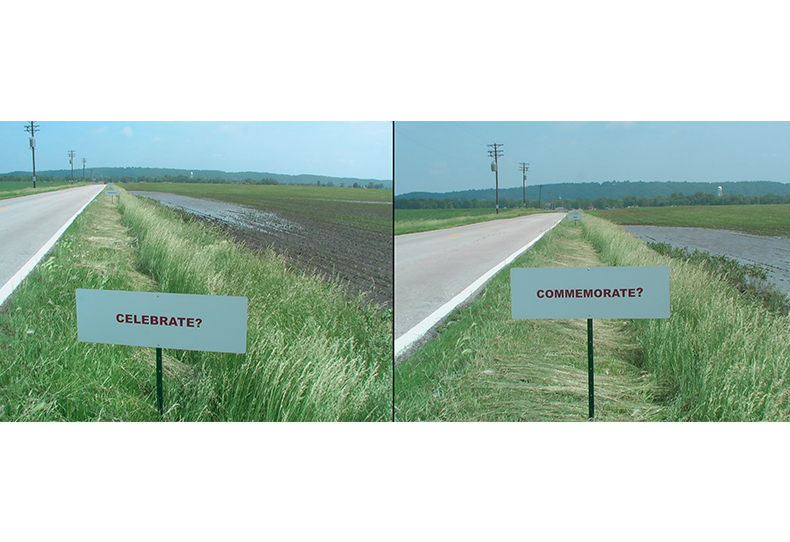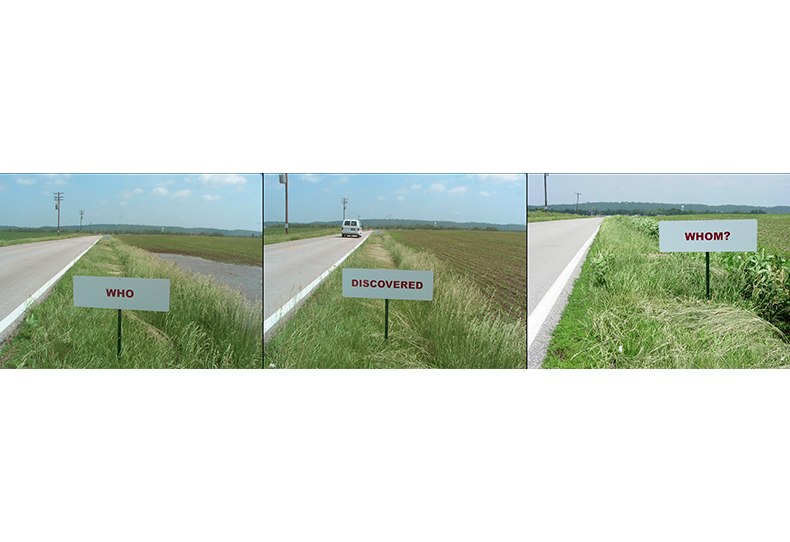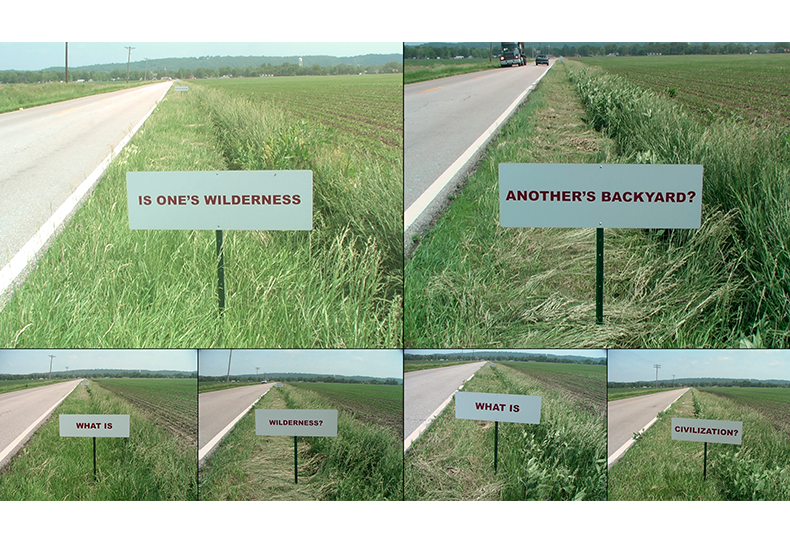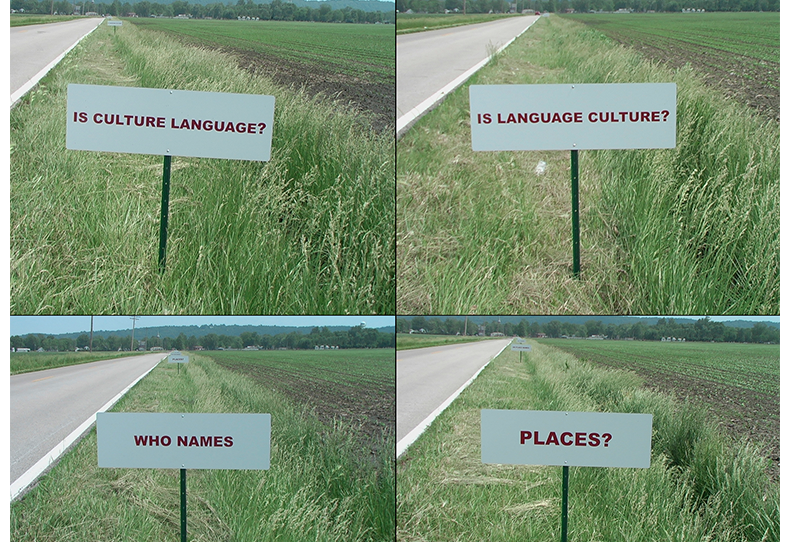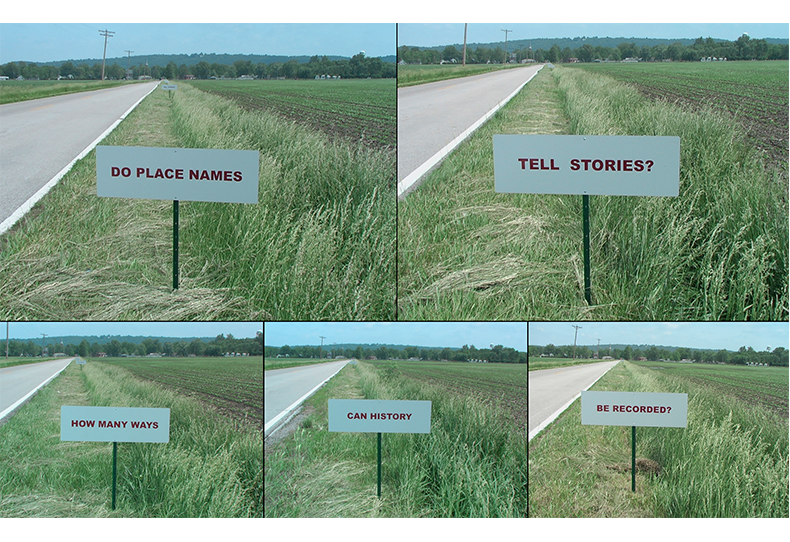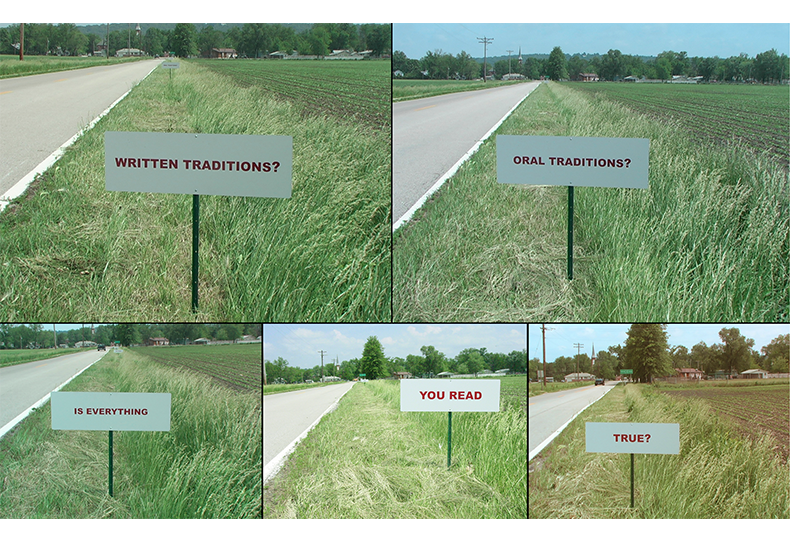
gourds and Longhorn steer horn transformed into sound trumpets for calling and listening, with galvanized steel trumpets, dimensions variable, 22 sound pieces echoing the history of the past 125 years, speakers and solar panels, sound system designed and fabricated by Lief Ellis and Karen McCoy.
Pictured is the site in Marvin Grove, University of Kansas, Lawrence, KS

Signage located at all three sites: 1) Entrance to the Spencer Museum, KU campus, Lawrence, KS
2) Marvin Grove, KU (Basswood tree)
3) Campus Green, Kansas City Art Institute, Kansas city, MO (Gingko tree)

Listening trumpets made from gourds modified for listening and colored with earth pigments from KS and MO

Listening trumpet fabricated from steel, galvanized (fabrication A. Zahner Architectural Metals

Listeners, installation in Basswood tree, Marvin Grove, KU campus (behind the Spencer Museum).

Listeners, installation in Basswood tree, Marvin Grove, KU campus (behind the Spencer Museum).

Listeners, installation in Basswood tree, Marvin Grove, KU campus (behind the Spencer Museum).

Listener with gourd trumpet, Marvin Grove, KU campus (behind the Spencer Museum).

Aerial view of installation components
Installation in Gingko tree campus green, Kansas City Art Institute, Kansas City, MO

Listeners and guests at opening, Installation in Gingko tree, campus green, Kansas City Art Institute, Kansas City, MO

Listeners and guests at opening, Installation in Gingko tree, campus green, Kansas City Art Institute, Kansas City, MO

Listeners and guests at opening, Installation in Gingko tree, campus green, Kansas City Art Institute, Kansas City, MO

Viewer using horn to speak to dog, campus green, Kansas City Art Institute, Kansas City, MO
Talking Trees
Karen McCoy with composer Robert Carl
Project commemorating the 125th anniversary of the Kansas City Art Institute, commissioned by the Spencer Art Museum, University of Kansas, Lawrence, KS, 2010
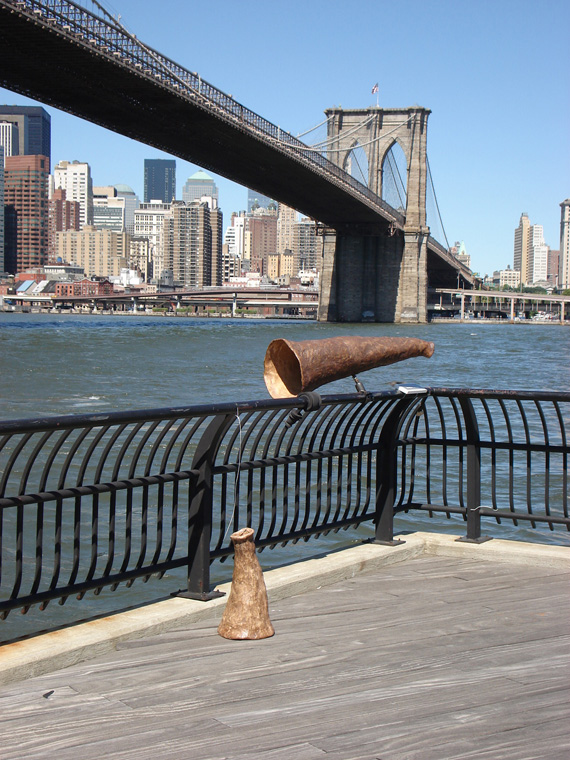
View of two trumpets, one mounted on a swivel clamp and another, for children or persons in wheel chairs, tethered to the railing.mounted trumpet: 45”L x 16”dia., tethered trumpet 18”L x 12” dia
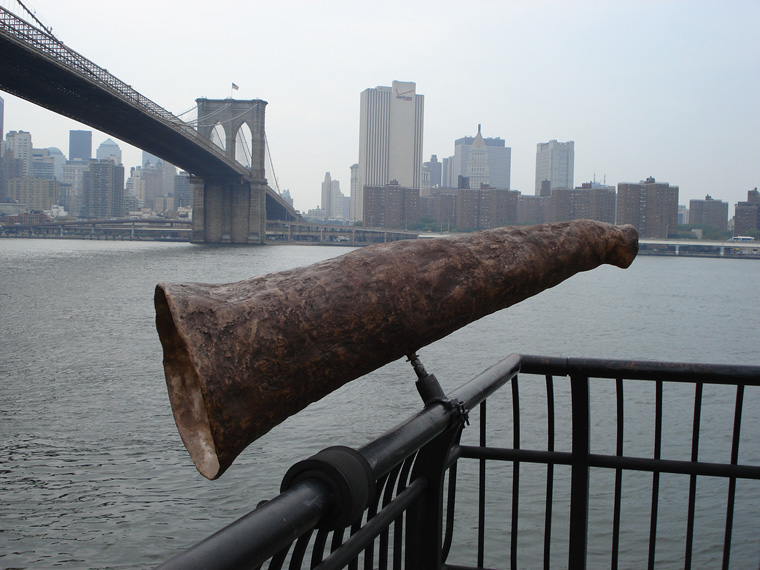
Detail of larger trumpet.
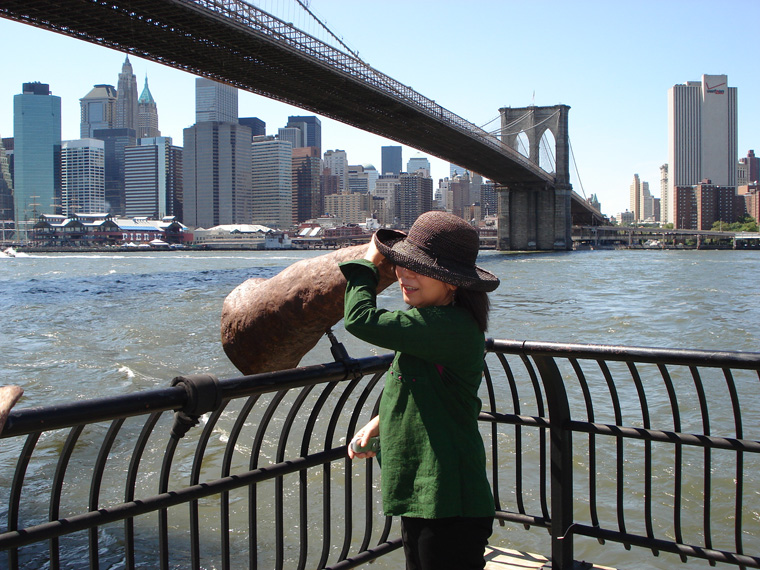
Visitor listening with mounted trumpet: 45”L x 16”dia.
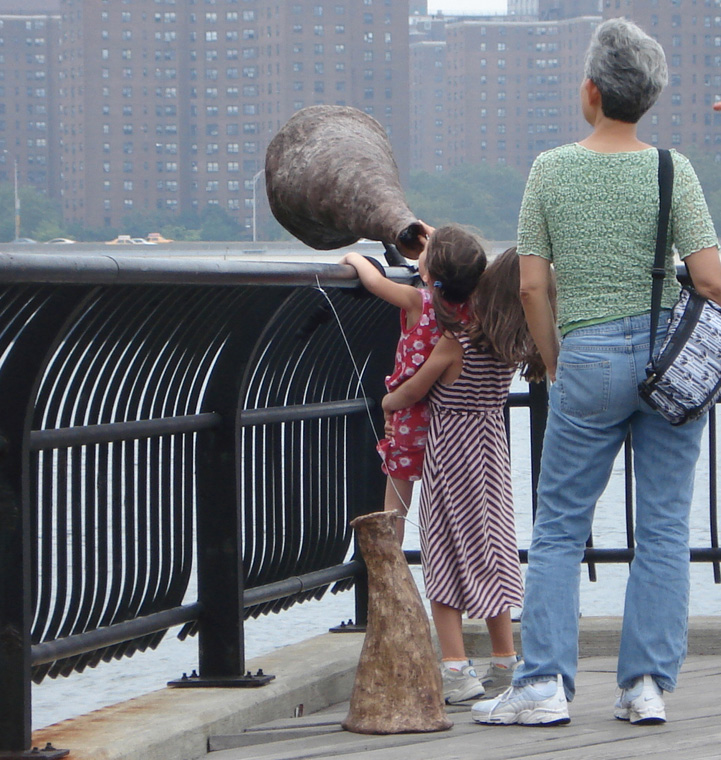
Child lifting child to see the framed view of Brooklyn Bridge.
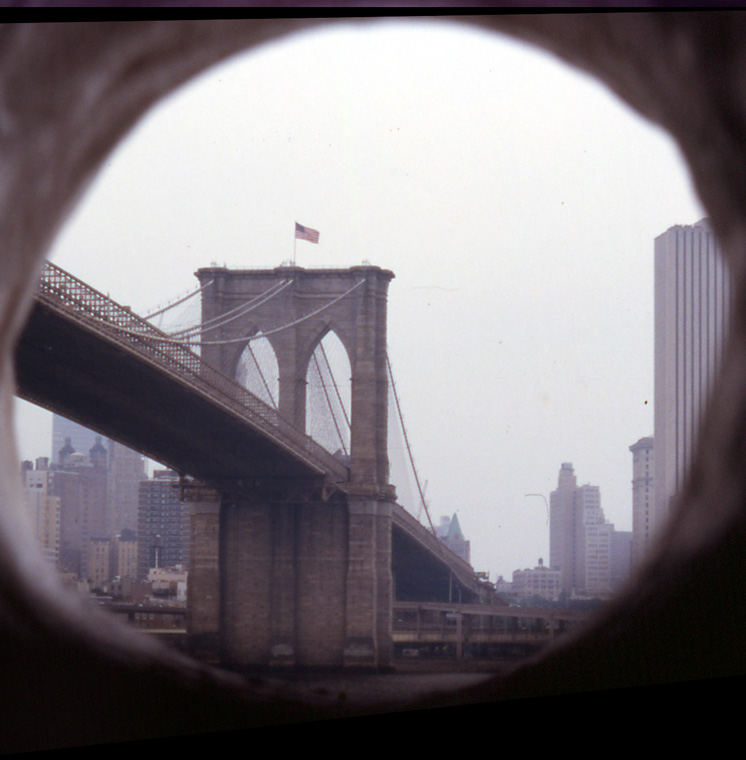
Framed view of Brooklyn Bridge.
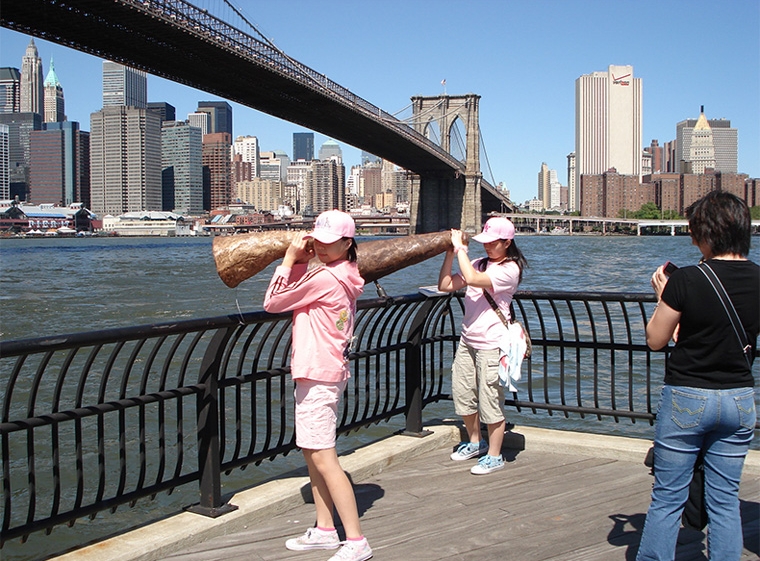
steel, polymerized hydrostone colored with pigments found on site, sealed with tung oil and resins, visitors listening
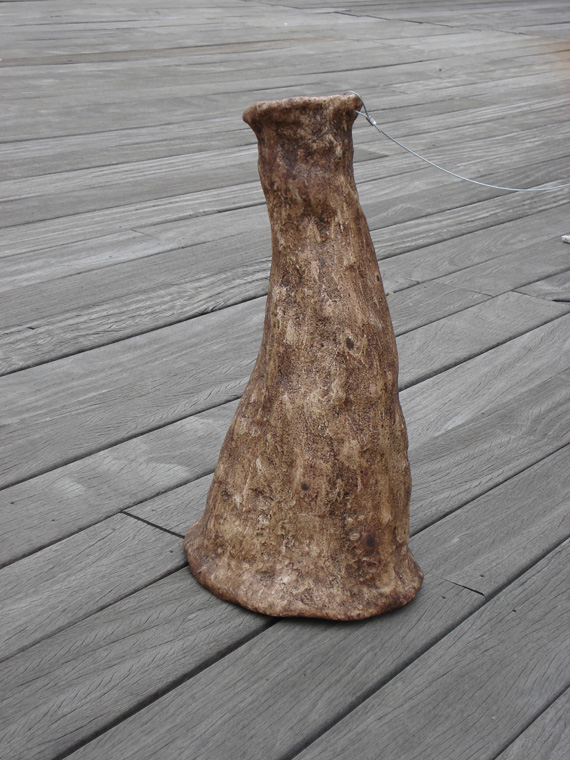
View of small trumpet.
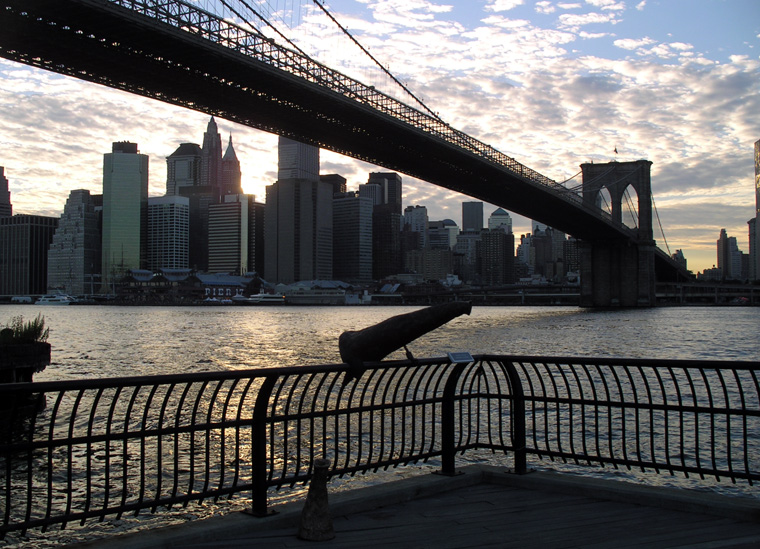
site at dusk. (Photo: Ed Kasperak)
Sound and Sight Trumpets for the East River
Brooklyn Artists Waterfront Coalition, Empire Fulton-Ferry State Park, Brooklyn, New York, 2006
steel, polymerized hydrostone colored with pigments found on site, sealed with tung oil and resins, mounted trumpet: 45”L x 16”dia., tethered trumpet 18”L x 12” dia.
One trumpet mounted on a swivel clamp and another---for children or persons in wheel chairs-- tethered to the railing.
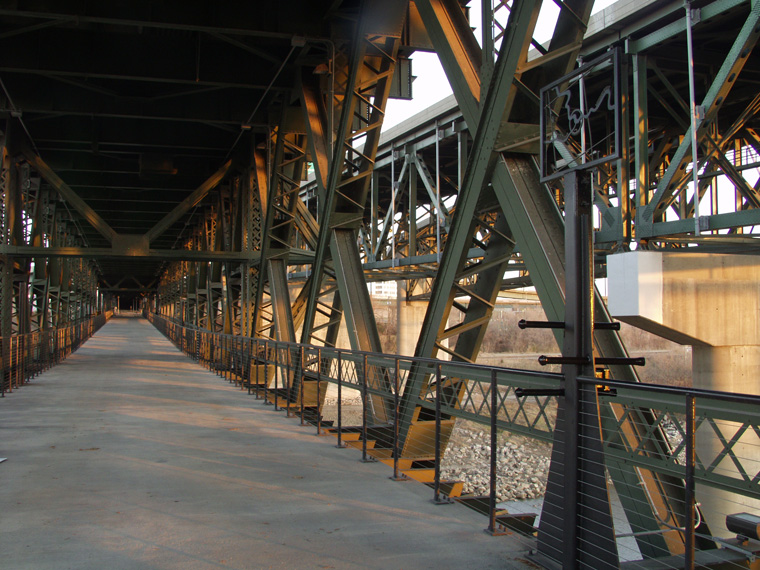
View of Confluence Station. Photo: Tim Dalton

View of Confluence Station, view of the diagram of the confluence of the Missouri and Kansas Rivers. Photo: Tim Dalton

View of Confluence Station, viewer looking at the confluence of the Missouri and Kansas Rivers (albeit through a railroad bridge). Photo: Tim Dalton

View of Confluence Station, view of the confluence of the Missouri and Kansas Rivers (through a railroad bridge). Photo: Tim Dalton
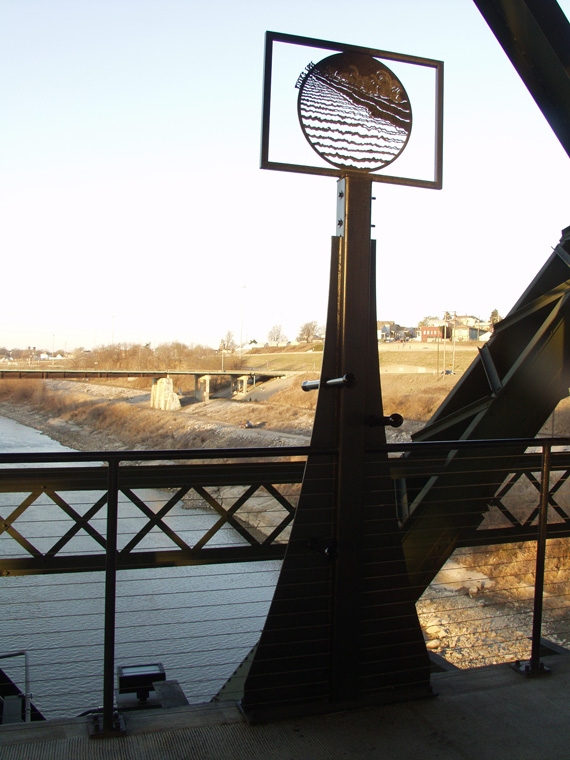
View of River’s Edge Station, Photo: Tim Dalton
View of River’s Edge diagram, Photo: Tim Dalton



Sighting Stations for the Woodswether Bicycle/Pedestrian Bridge: Confluence Station and River's Edge Station
Designed for barricade support system (support system itself designed by bridge engineer), Riverfront Heritage Trail, Kansas City, Kansas and Missouri, 2001 -2005
View of bridge interior where artists were asked to design “finials” for each barricade support structure. McCoy framed diagrams, made by water-jet cutting steel, and penetrated structures with sighting tubes made of galvanized and painted steel, frames - 35 x 44", tubes - 2" diameter x 24" long, structures - 124" H x 44" W x 24" D.

Osage Orange sapling planted in charred remains of a red oak tree, site prior to dedication, charred red oak in center with row of carved scoops awaiting use in planting ceremony and given as gifts to participants, carved by Matthew Dehaemers,native wildflower garden, site 17' high x 50' diameter.
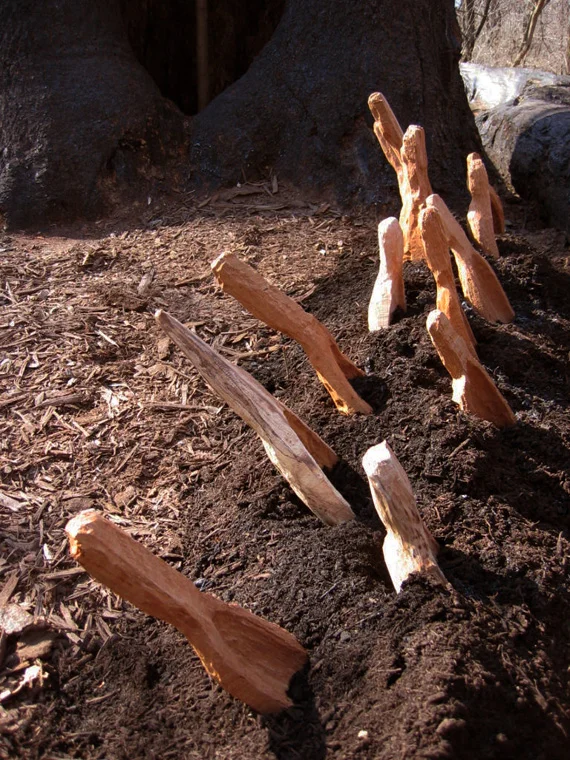
Detail, scoops awaiting use in planting at dedication ceremony and given as gifts to participants, carved by Matthew Dehaemers, each scoop, approximately 12 x 4 x 3"

Eddy Red Eagle, principle mentor to the artists, blessing the site in the Osage language, March 2003

Liesel Fenner, Arts Administrator for the Project, Arts in Community Landscapes, Massachusetts Foundation for the Arts, giving gifts from the Wampanoag to the Osage

Matthew Dehaemers, Sean StandingBear and Karen McCoy tethering the Osage Orange sapling, tethering stake carved and pigmented by Sean StandingBear.

Van Bighorse and the Osage Singers honoring the site with voice and drumming at dedication ceremony

Osage Elder Harry RedEagle participating in planting the Osage Orange sapling

detail of sapling inside red oak tree, May 2004 - 3 months after planting (photo Matthew Dehaemers).

before caretaking the native wildflower garden.

Clara Núñez-Regueiro, Osage Nation Inter-Institutional Cultural Advisor, with her daughter Valerie Núñez-Regueiro weeding the Tree in Tree native wildflower garden, May 2007 (photo Mauricio Núñez-Regueiro).

View of Osage Orange sapling growing from red oak trunk, May 2008

Detail of tethered Osage Orange sapling branch May 2008
Tree in Tree
with Matthew Dehaemers and members of the Osage Nation, Kennedy Forest, Forest Park, St. Louis, Missouri, 2004.
Osage Orange sapling planted in charred remains of a red oak tree, dedication ceremony, native wildflower garden, site 17' high x 50' diameter.
Epicenter
with Matthew Dehaemers, Lewis and Clark Interpretive Center, Hartford, IL, 2004
One half ton of Mississippi River water frozen into the form of a dugout canoe, ears of corn fill canoe which rests on a bed of uprooted corn stalks, canoe 12' L x 2' W x 19.5" D.
Who Discovered Whom?
with Matthew Dehaemers, Portage des Sioux, Missouri, 2004
25 enameled steel signs, each 15 x 35" containing 12 questions, route J into town, 1 mile long.

Falls of the Ohio at Louisville, KY, aerial photo from commercial jet, Karen McCoy, 2003

Crinoid laden fossil stone from the Falls of the Ohio, lent to the artists by the Falls of the Ohio Interpretive Center, Clarksville, IN

Crinoid soil-stone from set made for Turning the Tide with choreographer Melli Hoppe, 2003, soil from Clarksville, IN and cement, 12 x 14 x4”.
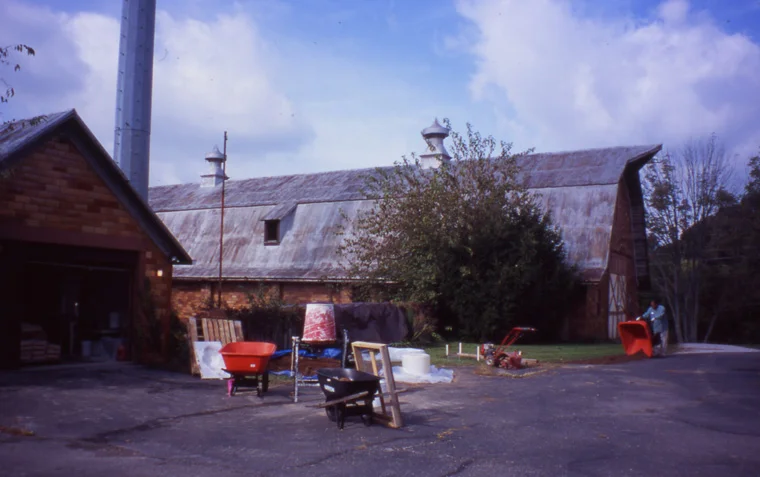
Studio at Mary Anderson Center for the Arts, Mt. St. Francis, IN, 2003

Turning the Tide, two week making-talking event in tent at Lewis and Clark Bicentennial Commemoration, Louisville, KY, with choreographer Melli Hoppe, 2003

Turning the Tide, with choreographer Melli Hoppe, Detail of work process, 2003

Turning the Tide, choreographer Melli Hoppe, Detail of three soil stones with soil from Bagdad, KY, Mt. St. Francis and the Mingo Nation, Ohio, 2003, 12 x 14 x4”.

With choreographer Melli Hoppe, Detail of tent interior. Detail of tent interior, McCoy center, with re-enactor and vidographer, 2003

Current
Melli Hoppe and Susurrus, pilot project choreographed from materials gathered in Turning the Tide, 2005, performed at Butler College, Indianapolis, IN
Turning the Tide
with Melli Hoppe, TURNING THE TIDE, The Falls of the Ohio at Louisville, Kentucky and Clarksville, Indiana, 2003.
Sound Stations
Freight House Project, Kansas City, MO, 1999
a pair of rotating, etched cor ten steel ear trumpets, landscaped area including limestone flagstone paving bearing watermarks laid in the shape of waves that intrude into the adjacent parking area, boulders for standing or sitting, an earthen berm under viaduct, native prairie and imported grasses, and gingko trees.
Each trumpet 3 x 1 x 4' H with a 360 degree rotation, site, approximately 30 x 200'




